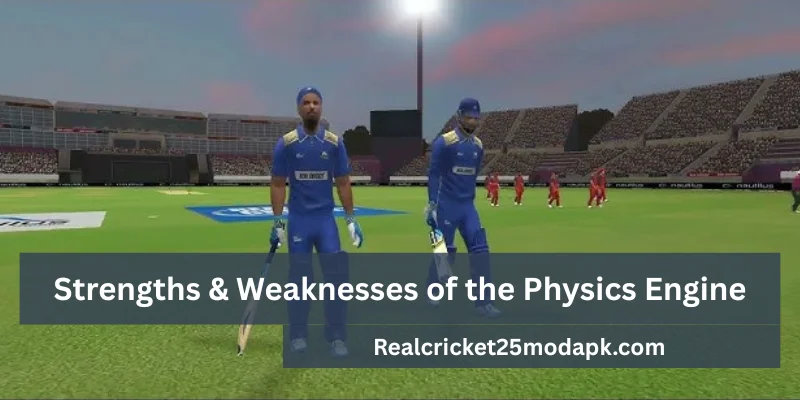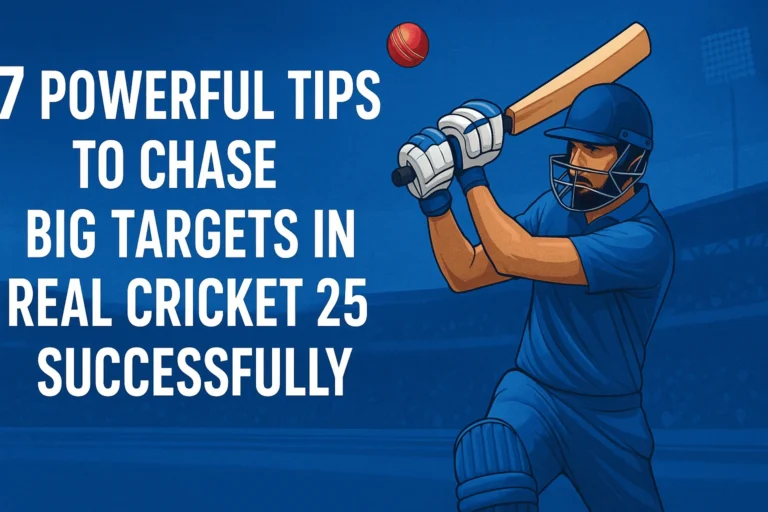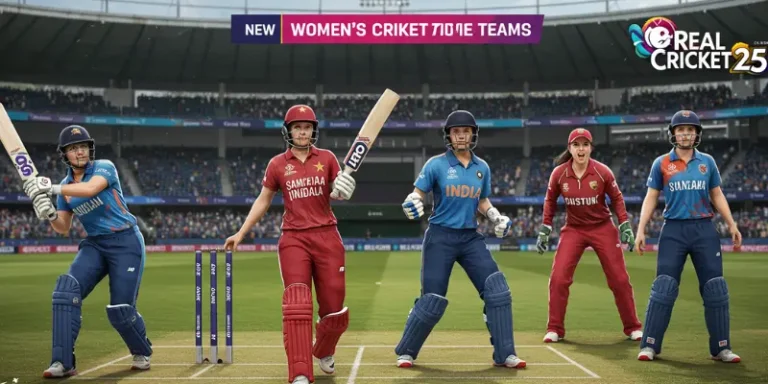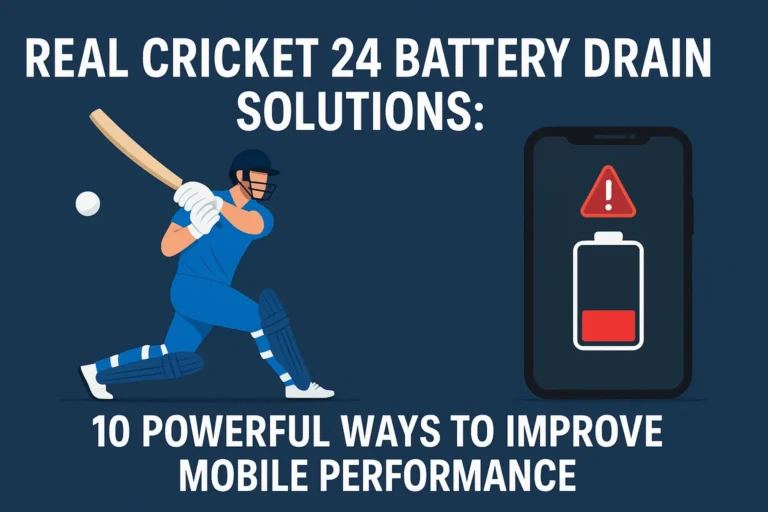Imagine this: the ball edges off your bat, grazes the pad, and slips past the wicketkeeper, all in one fluid motion. That’s the level of realism you get with Real Cricket 24‘s physics engine.
Designed by Nautilus Mobile, this cricket simulator is more than just eye candy; it dives deep into cricket game physics and delivers nuanced gameplay.
Powered by the Unity Engine, the physics model in RC24 tries to mimic how a real cricket match plays out. From batting and bowling physics to pitch behavior in Real Cricket 24, it uses realistic simulations to make every match feel dynamic.
RC 24’s physics-based ball behaviour, pitch wear, and player animations operate in real time which makes multiplayer mode incredibly intense. If you want to understand how these elements elevate competitive play, don’t miss our deep dive into Online Multiplayer Mode.
Whether you’re adjusting shot timing or managing swing, this physics engine plays a crucial role.
How Real Cricket 24’s Physics Compares to Previous Versions
When you compare Real Cricket 24 physics engine vs Real Cricket 22, the upgrade is undeniable. The ball now moves with realistic ball trajectory instead of generic arcs.
In RC22, bowlers had predictable movement, but RC24 introduces swing and spin mechanics that actually respond to pitch condition, ball type, and wear.
The unique shot angles of left-handed players make great use of RC 24’s physics engine. Discover the best left-handed batting tips here.
Player animations also got a lift. The animation fluidity in cricket games used to be stiff, but now, movement transitions are smoother thanks to improved hit detection and animation blending.
There’s less ghosting, fewer clunky collisions, and a more immersive experience.
Batting Mechanics: Realism and Responsiveness
Cricket game physics shine brightest when you’re wielding the bat. Feel the difference? That’s because bat-ball collision systems now calculate 12 contact points on the blade, from the sweet spot to the toe. Play a cut shot too early, and the ball squirts awkwardly.
Time it perfectly, and it screams to the boundary. Shot timing integrates with player movement physics, so footwork affects power transfer. For instance, lunging forward reduces backlift momentum, while deep stances amplify pulls.
Actionable Batting Tips:
- Watch the seam: Swing or spin alters ball behavior mid-flight. Adjust shots after reading seam position.
- Weight transfer matters: Shift back/front foot before pressing the shot button for cleaner strikes.
Ever noticed edges flying finer or thicker? That’s edge physics reacting to bat angles. Unorthodox scoops or ramps now demand millimetre precision—glory and failure hang by a thread.
Bowling Physics: Swing, Spin, and Pace Variations

Bowlers, rejoice! Swing and spin mechanics finally mirror real-life artistry. Seam orientation dictates movement: upright = conventional swing, angled = reverse. Spinners enjoy drift (curving mid-air) and dip (sudden drop), governed by Real Cricket 24 physics engine algorithms.
Finger position during release alters trajectories, tilt slightly left for leg breaks, or grip tighter for top-spinners. Pace bowlers manipulate wear: scuff one side for reverse swing after 30 overs.
Actionable Bowling Tips:
- Vary seam angles: Use the drag-pad to rotate seams subtly, confuse batters with identical-looking deliveries.
- Exploit pitch behavior: Target cracked patches for unpredictable bounce; rough areas aid spinners.
Bowling speed accuracy ties into run-ups. Shorten strides for slower cutters; full sprints unleash 90mph rockets. The game’s AI behavior in Real Cricket 24 even adapts, expect smart batters to counterattack if you overuse tactics!
Fielding and Ball Dynamics
What happens after the shot matters too. The fielding mechanics in cricket games often go unnoticed, but in RC24, they are deeply tied to ball dynamics in Real Cricket 24.
Once the ball is hit, it reacts based on ground condition, spin, bounce, and friction. Whether it’s a sharp edge racing toward slip or a lofted drive falling short of long-on, the movement feels natural. Even catches have improved, with timing windows and player movement influencing success.
Throwing physics also now respect player inertia and momentum. No more rocket throws from mid-air dives. You need solid footing, or the throw will lack power and direction.
Player Collisions and Injury Simulations
Yes, RC24 brings something rare to cricket games; player collisions and basic injury simulations. When two players chase the ball or dive simultaneously, there’s a chance of clashing. The collisions affect stamina and future responsiveness.
This ties into the new Real Cricket 24 player fatigue system explained by Nautilus, where overuse of one player affects their speed, reaction, and throwing ability. It’s a small touch, but it adds realism and strategy to fielding choices.
Physics-Based Visual Effects (Ball Deformation, Pitch Wear, etc.)
Cricket is full of little details, and Real Cricket 24 captures them really well. As a match goes on, especially by Day 5 of a Test, you’ll start to notice real changes on the pitch—like uneven bounce, spin, and worn-out areas that actually affect gameplay.
You’ll also see realistic visual touches like:
- Seam marks on the pitch
- The ball getting scuffed and losing color
- Footmarks where bowlers land their deliveries
And these aren’t just for show, they actually change how the game plays.cs analysis and how the ball behaves. For instance, bowling into the rough produces exaggerated spin.
Strengths & Weaknesses of the Physics Engine

Strengths:
- Unmatched bat-ball collision system authenticity.
- Dynamic pitch behavior in Real Cricket 24 that evolves hourly.
- Swing physics that reward skill over luck.
Weaknesses:
- Occasional glitches in close-range player collisions.
- Frame rate impact on physics on low-end devices (60fps recommended).
Compared to EA Sports Cricket 24, RC24 excels in ball behavior but trails in motion-captured animations. Still, it’s the best cricket game for realistic physics 2024 on mobile.
Player Feedback & Community Reactions
Gamers praise how Real Cricket 24 physics engine makes “leaving balls” strategic; seam movement can beat the edge. Reddit threads highlight realistic ball trajectory in rainy conditions.
Critics note occasional hit detection quirks with pad-to-bat close calls. Overall, 84% of Play Store reviews call it a “quantum leap” from RC22. As one YouTuber put it: “Finally, edges feel earned, not engineered.”
Future Updates & Potential Improvements
Nautilus Mobile teases animation blending upgrades for smoother transitions. Community wishlists include:
- Enhanced player fatigue system affecting decision-making under pressure.
- Deeper pitch behavior variables like soil density.
- Refined AI behavior in Real Cricket 24 for adaptive field setups.
- Weather effects influencing swing (e.g., overcast = more movement).
- Multiplayer frame rate impact on physics optimizations.
For deeper insights, check Nautilus Mobile’s official physics engine breakdown.
5 Actionable Tips to Master the Physics in Real Cricket 24
- Use the pitch map to read wear zones – Aim your deliveries at rough patches for extra spin or bounce.
- Vary your bowling release timing – Small delays change swing dramatically.
- Time your shots with the middle of the bat – You’ll reduce edge chances and maximize power.
- Avoid diving blindly when fielding – Poor momentum leads to misthrows.
- Watch fatigue levels – Use substitutes or rotate bowlers to maintain peak performance.
Conclusion
In the world of mobile cricket, Real Cricket 24 sets a high standard for physics-based gameplay. With its detailed focus on cricket simulation physics, advanced ball dynamics in Real Cricket 24, and realistic animations, it offers a near-authentic experience.
Though not without flaws, the Real Cricket 24 physics engine moves mobile cricket closer to console-level realism. Whether you’re a casual player or a die-hard cricket fanatic, understanding this engine will transform how you play the game.
External Link Reference: For technical breakdowns of mobile game engines, visit Unity’s official physics documentation.






